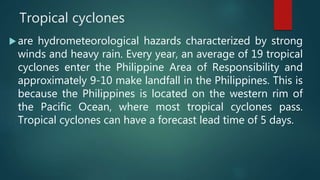Precautionary and safety measures for hydrometeorological hazard
- 1. Tropical cyclones ?are hydrometeorological hazards characterized by strong winds and heavy rain. Every year, an average of 19 tropical cyclones enter the Philippine Area of Responsibility and approximately 9-10 make landfall in the Philippines. This is because the Philippines is located on the western rim of the Pacific Ocean, where most tropical cyclones pass. Tropical cyclones can have a forecast lead time of 5 days.
- 3. Thunderstorms ?are generally local storms produced by cumulonimbus clouds and are always accompanied by lightning and thunder, usually with strong wind gusts, heavy rain and sometimes with hail and/or tornado. Thunderstorms are typical in warm environments like the tropics and may persist for 1 to 2 hours.
- 5. Flood ?is the overflowing of the normal confines of a stream or bodies of water, or the accumulation of water over areas that are not normally submerged. While flooding may last days or even weeks, Flash Floods are also caused by heavy precipitation in a short period of time, usually less than 6 hours.
- 7. Storm surge ? is the rise and onshore surge of seawater as the result primarily of the winds of a tropical cyclone, and secondarily of the surface pressure drop near the center of the tropical cyclone. The height of storm surge is dependent on the size, intensity and movement of the tropical cyclone, shape of the coastline as well as nearshore underwater topography and astronomical tides. Below is a list of things that you can to do before, during and after a storm surge event.
- 9. El Ni?o ?is a significant increase in ocean temperature over the eastern and central Pacific ocean. It occurs at irregular intervals ranging from 2-7 years usually developing in the early months of the year and decay the following year. In the Philippines, El Ni?o conditions are often characterized by dry and warm-hot events.
- 12. Return period ?also referred to as recurrence interval, is the probability of an event such as heavy rain, intense typhoon of floods to happen. It is a statistical measurement mainly based on historical data that gives the estimated time interval between similar extreme events.
- 13. For example: ? the return period of a heavy rainfall event is 100 years, this can be expressed as an event with a probability of happening equivalent to 1/100 or 1%. This does not mean that the next similar extreme event will happen 100 years after, instead, it means that in a given year, there is a 1% chance what the event will happen. Consequently, 100-year floods can happen in 2 consecutive years. In analysis of extreme hydrometeorological events, ¡°return periods¡± are usually used to infer the severity of an event.
- 14. Rainfall in the Philippines ? Rainfall is the most important climatic element in the Philippines. Rainfall distribution throughout the country varies from one region to another, depending upon the direction of the moisture-bearing winds and the location of the mountain systems. ? The mean annual rainfall of the Philippines varies from 965 to 4,064 millimeters annually. Baguio City, eastern Samar, and eastern Surigao receive the greatest amount of rainfall while the southern portion of Cotabato receives the least amount of rain. At General Santos City in Cotabato, the average annual rainfall is only 978 millimeters for the whole year. What is the usual rainfall in you area?
- 16. ?While we are usually concerned with heavy rainfall events, lack of rain is also a significant condition that we also experience. Weather in different parts of the Philippines can vary significantly for certain years as a response to changing global climate. One of the main climate drivers that affect the Philippines is the El Ni?o Southern Oscillation (ENSO) or simply El Ni?o.
- 19. PAGASA ? The Philippine Atmospheric, Geophysical and Astronomical Services Administration (which means "hope" as in the Tagalog word pag-asa) is the National Meteorological and Hydrological Services (NMHS) agency of the Republic of the Philippines mandated to provide protection against natural calamities and to insure the safety, well-being and economic security of all the people, and for the promotion of national progress by undertaking scientific and technological servicesin meteorology, hydrology, climatology, astronomyand other geophysical sciences
- 23. The Nationwide Operational Assessment of Hazards ?or NOAH is a program under the Department of Science and Technology (DOST) with the mission to undertake disaster science research and development, advance the use of cutting edge technology and recommend innovative information services in government¡¯s disaster prevention and mitigation efforts. DOST-NOAH can be accessed online at http://noah.dost.gov.ph.
- 27. Nababaha.com ?Another local website, http://www.nababaha.com, a non- profit project by the members of the Volcano-Techtonics Laboratory of the National Institute of Geological Sciences of University of the Philippines, publishes a list of flood hazard maps of different regions (http://www.nababaha.com/list.htm), with the same dataset as DOST-NOAH.
- 30. National Mapping and Resource Information Authority ? is an agency of the Philippine government under the Department of Environment and Natural Resources (DENR) responsible for providing the public with mapmaking services and acting as the central mapping agency, depository, and distribution facility of natural resources data in the form of maps, charts, texts, and statistics. On its website¡¯s download page, http://www.namria.gov.ph/download.php,hazard/susceptibility maps for storm surge, rain-induced landslide and flood are freely available.
- 33. The Mines and Geosciences Bureau ?a government agency also under the Department of Environment and Natural Resources (DENR), is responsible for the conservation, management, development and proper use of the country¡¯s mineral resources including those in reservations and lands of public domains. MGB maintains a geohazard visualization portal accessible at this URL http://gdis.denr.gov.ph/mgbgoogle/.

































